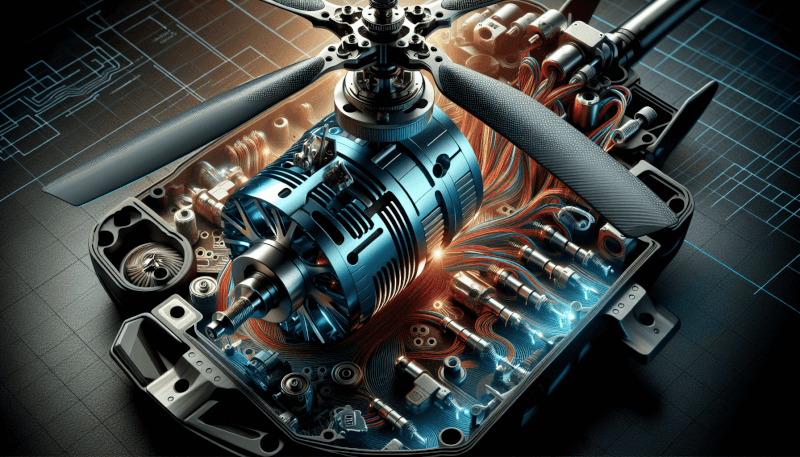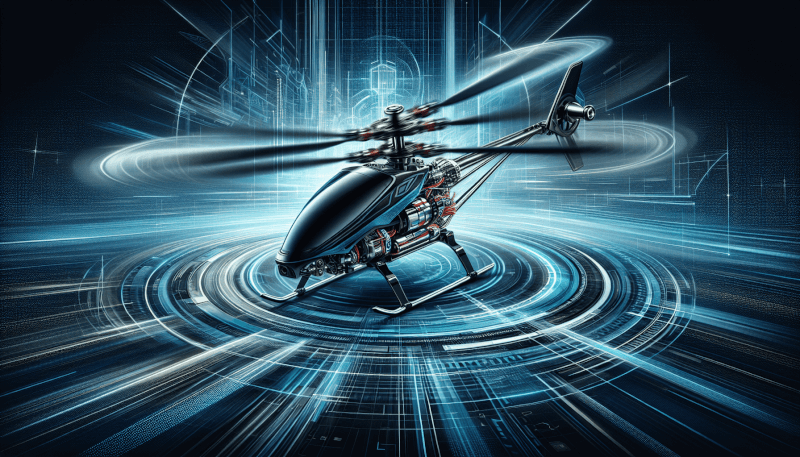Imagine a world where your RC helicopter effortlessly hovers in the sky, gliding through the air with unparalleled ease and precision. Sound like a dream? Well, thanks to the rapid advancement of brushless motors, this dream is quickly becoming a reality. These compact yet powerful motors are revolutionizing the RC helicopter industry, offering increased efficiency, longer flight times, and improved performance. In this article, we will explore the exciting future of brushless motors in RC helicopters and how they are transforming the way we experience remote-controlled flight.

Advantages of Brushless Motors
Higher power-to-weight ratio
One of the major advantages of brushless motors is their higher power-to-weight ratio. Compared to traditional brushed motors, brushless motors are able to deliver more power while being lighter in weight. This allows for better performance and maneuverability in RC helicopters, as the power output is maximized without adding unnecessary weight to the aircraft.
Increased efficiency
Brushless motors are known for their increased efficiency compared to brushed motors. This is mainly due to the absence of brushes and commutators, which are common components in brushed motors. The lack of these friction-inducing parts in brushless motors results in less energy loss, allowing for more efficient and effective power delivery to the rotor blades. As a result, RC helicopters with brushless motors are able to fly longer and require less battery power.
Longer lifespan
Another significant advantage of brushless motors is their longer lifespan. Unlike brushed motors, which are prone to wear and tear due to the friction caused by the brushes and commutators, brushless motors have a much longer operating life. This is because brushless motors have a more durable design and do not have any physical contact between moving parts, resulting in reduced maintenance and replacement costs for RC helicopter enthusiasts.
Faster response times
Brushless motors are also known for their faster response times, making them ideal for RC helicopters that require quick and precise maneuvering. The absence of brushes and commutators allows brushless motors to have instant acceleration and deceleration, enabling RC helicopter pilots to have better control over the aircraft’s movements. This faster response time contributes to enhanced performance and improved flying experience for the operators.
Reduced maintenance
One of the advantages that make brushless motors popular among RC helicopter enthusiasts is their reduced maintenance requirements. As mentioned earlier, brushless motors do not have brushes and commutators, which are prone to wear and tear. This means that RC helicopter owners do not have to spend as much time and effort on cleaning and replacing these components. Additionally, brushless motors typically have sealed bearings, further reducing the need for maintenance and ensuring longer periods of uninterrupted flying.
Enhanced Performance
Improved power delivery
Brushless motors offer improved power delivery compared to their brushed counterparts. The design of brushless motors allows for a more direct transfer of power from the electric current to the rotor blades, resulting in a more efficient use of energy. This translates to increased power output and better overall performance of RC helicopters equipped with brushless motors.
Higher RPM range
Brushless motors have a higher RPM range compared to brushed motors. This means that RC helicopters with brushless motors can achieve higher speeds and faster rotations, allowing for more dynamic and exciting flight experiences. The higher RPM range also enables RC helicopter pilots to execute advanced aerial maneuvers with ease and precision.
Precise motor control
One of the key advantages of brushless motors is the precise control they provide. The design of brushless motors allows for finer adjustments in rotor speed and direction, enabling RC helicopter pilots to have better control over their aircraft. This precise motor control contributes to improved stability, maneuverability, and responsiveness, making brushless motors an ideal choice for both beginners and experienced RC helicopter pilots.
Enhanced maneuverability
Brushless motors offer enhanced maneuverability for RC helicopters. The higher power-to-weight ratio, increased efficiency, and faster response times of brushless motors allow for more agile and nimble flight characteristics. RC helicopter pilots can perform tight turns, quick climbs, and precise landings with ease, giving them more control over their aircraft in various flying conditions. This enhanced maneuverability opens up a world of possibilities for RC helicopter enthusiasts, enabling them to explore new flight techniques and execute complex aerial maneuvers.
Technological Advancements
Development of more powerful magnets
One of the technological advancements that have contributed to the rise of brushless motors is the development of more powerful magnets. Brushless motors use permanent magnets, typically made of neodymium, to generate the magnetic field required for rotor rotation. The continuous improvement in magnet technology has led to the production of magnets with higher coercivity and energy density, resulting in brushless motors with increased power output and efficiency.
Advances in motor controller technology
Motor controllers play a crucial role in the operation of brushless motors. These electronic devices regulate the power output to the motor, ensuring smooth and controlled operation. Advances in motor controller technology have enabled the development of more sophisticated and efficient motor control systems for brushless motors. These systems can optimize power delivery, improve responsiveness, and provide additional features such as multiple flight modes and integrated safety mechanisms.
Integration with electronic stability systems
The integration of brushless motors with electronic stability systems has revolutionized the performance of RC helicopters. These stability systems, commonly known as gyroscopes, utilize sensors to detect and counteract unwanted movements or instability in the aircraft. By working in conjunction with brushless motors, electronic stability systems can provide enhanced stability, reduce vibrations, and improve overall flight control. This integration has made RC helicopters more stable, precise, and easier to fly, contributing to the growing popularity of brushless motors.
Wireless connectivity and control
With the advancements in wireless communication technology, brushless motors can now be wirelessly connected and controlled via various devices, such as smartphones and tablets. This wireless connectivity allows RC helicopter pilots to have more flexibility and convenience in controlling their aircraft. It also opens up possibilities for advanced features such as real-time data monitoring, firmware updates, and the ability to program custom flight parameters. The integration of wireless connectivity and control further enhances the user experience and expands the potential applications of brushless motors in RC helicopters.
Increasing Popularity
Growing number of RC helicopter enthusiasts
The popularity of RC helicopters has been steadily increasing, leading to a growing community of enthusiasts. With more people getting involved in the hobby, there is a greater demand for advanced and high-performance equipment, including brushless motors. The expanding community of RC helicopter enthusiasts not only drives the development and availability of brushless motors but also fosters a supportive and engaging environment for pilots to share their experiences and knowledge.
Wider availability of brushless motors
As the demand for brushless motors continues to rise, the availability of these motors has become more widespread. Hobby shops, online retailers, and specialized RC helicopter stores now offer a wide range of brushless motors suitable for various aircraft sizes and applications. The increased availability of brushless motors makes it easier for RC helicopter enthusiasts to upgrade their existing aircraft or build new models that take advantage of the benefits offered by brushless motor technology.
Affordable pricing options
While brushless motors were initially more expensive than brushed motors, advancements in manufacturing processes and increased competition have made brushless motors more affordable. As a result, RC helicopter pilots can now enjoy the advantages of brushless motors without breaking the bank. Affordable pricing options make brushless motors accessible to a broader range of enthusiasts, allowing more people to experience the enhanced performance, longer lifespan, and other benefits that brushless motors offer.
Increased adoption by professional pilots
Professional RC helicopter pilots have been quick to recognize the advantages of brushless motors and have embraced their use in competitions, aerial shows, and other professional applications. The superior performance, enhanced maneuverability, and precise control offered by brushless motors make them an excellent choice for professional pilots who seek to push the limits of their aircraft and demonstrate their skills. The increased adoption of brushless motors by professional pilots further validates their effectiveness and solidifies their position as a game-changer in the world of RC helicopters.

Application in Racing
Superior acceleration and speed
Brushless motors have become a staple in RC helicopter racing due to their superior acceleration and speed capabilities. The high power output, efficient power delivery, and optimized motor control systems of brushless motors allow racing helicopters to achieve impressive acceleration rates and reach high speeds. This makes brushless motors essential for competitive racing, where every second and every fraction of speed matters.
Improved maneuverability in tight spaces
In racing competitions, RC helicopters often have to navigate through tight and challenging courses. Brushless motors provide the necessary maneuverability for these demanding conditions. With their enhanced performance and precise control, brushless motors allow pilots to execute quick turns, sharp corners, and rapid changes in direction. The ability to maneuver with agility and precision is crucial in racing, where split-second decisions can determine the outcome of a race.
Ability to execute complex aerial tricks
Brushless motors offer the power and responsiveness required to execute complex aerial tricks and stunts. With their higher RPM range and improved maneuverability, RC helicopters equipped with brushless motors can perform a wide variety of advanced maneuvers, such as rolls, flips, and inverted flight. These tricks not only showcase the capabilities of the aircraft but also add excitement and entertainment value to RC helicopter races and exhibitions.
Reduction in component weight for better handling
The lightweight design of brushless motors contributes to better handling in racing conditions. By reducing the overall weight of the RC helicopter, brushless motors allow for quicker response times, improved agility, and more precise control. The reduced component weight also minimizes the strain on other helicopter parts, such as the frame and rotor blades, resulting in improved durability and increased lifespan. This combination of reduced weight and enhanced handling makes brushless motors a preferred choice for RC helicopter racing applications.
Commercial and Industrial Uses
Aerial photography and filming
The use of RC helicopters in aerial photography and filming has gained significant popularity in recent years. Brushless motors play a crucial role in these applications, as they provide the power, stability, and control required to capture high-quality aerial footage. With their precise motor control, enhanced maneuverability, and reduced vibrations, brushless motors enable smooth and stable flight, allowing photographers and filmmakers to capture breathtaking shots from unique perspectives.
Delivery and logistics operations
Brushless motors have also found applications in delivery and logistics operations. The maneuverability, efficiency, and longer flight duration offered by brushless motors make them suitable for unmanned aerial vehicles (UAVs) used for package delivery, inventory management, and other logistical activities. The improved power-to-weight ratio and precise control of brushless motors contribute to the safe and reliable transportation of goods, making them a valuable asset in the commercial sector.
Search and rescue missions
RC helicopters equipped with brushless motors have proven to be invaluable tools in search and rescue missions. The enhanced maneuverability, extended flight duration, and precise control of brushless motors enable pilots to navigate difficult terrains and reach remote locations with ease. The ability to hover in place and perform precise movements allows the rescue teams to conduct visual inspections, deliver supplies, and perform aerial reconnaissance, greatly aiding in the efficiency and effectiveness of search and rescue operations.
Agricultural and crop spraying applications
Brushless motors have found applications in agriculture for crop spraying and pesticide dissemination. The power and efficiency of brushless motors enable agricultural drones to carry heavier payloads, cover larger areas, and operate for longer periods of time. The precise motor control and maneuverability of brushless motors allow pilots to perform accurate and controlled spraying operations, minimizing wastage and ensuring the effective distribution of agricultural agents. This application of brushless motors in agriculture is not only efficient but also helps reduce the environmental impact of traditional farming practices.

Energy Efficiency and Battery Life
Reduced power consumption
Brushless motors are known for their energy efficiency. The absence of brushes and commutators eliminates the need for constant power supply to these components, resulting in reduced power consumption. This energy-saving feature allows RC helicopters with brushless motors to fly longer on a single battery charge, extending the flight duration and enhancing the overall flying experience for pilots.
Extended flight duration
The efficiency and power-saving capabilities of brushless motors contribute to extended flight durations. With their improved power-to-weight ratio and reduced energy losses, brushless motors enable RC helicopters to stay in the air for longer periods of time compared to brushed motors. This extended flight duration is particularly beneficial for aerial photography, filming, and other applications where longer operating times are required.
Compatibility with larger capacity batteries
Brushless motors can handle larger capacity batteries, further extending the flight duration of RC helicopters. The design and power requirements of brushless motors allow for the use of higher capacity lithium-polymer (LiPo) batteries, which store more energy and provide longer-lasting power. The compatibility with larger capacity batteries enhances the performance and versatility of RC helicopters, allowing pilots to undertake more challenging missions and operations without the need for frequent battery changes.
Improved overall system efficiency
The improved efficiency of brushless motors translates to improved overall system efficiency in RC helicopters. By optimizing power consumption, reducing energy losses, and offering more precise control, brushless motors contribute to a more efficient and effective operation of the entire aircraft. This improved system efficiency not only benefits the performance and flight duration but also enhances the longevity of other helicopter components, such as the battery, electronic systems, and mechanical parts.
Low Noise and Vibration
Quieter operation for reduced noise pollution
Brushless motors are known for their quiet operation, making them ideal for applications where noise reduction is critical. Compared to brushed motors, which produce considerable noise due to the physical contact between brushes and commutators, brushless motors operate with minimal noise. The reduced noise levels contribute to a quieter and more enjoyable flying experience for both the pilot and the surrounding environment, while also minimizing noise pollution in residential areas or public spaces.
Improved comfort during flight
The low noise levels of brushless motors contribute to improved comfort during RC helicopter flights. The absence of the loud humming or buzzing associated with brushed motors makes the flying experience more pleasant and less fatiguing for pilots and passengers. This enhanced comfort allows for longer flight durations without discomfort, enabling pilots to focus on flying and enjoying their RC helicopters to the fullest.
Lower vibration levels for enhanced stability
Brushless motors produce less vibration compared to brushed motors, resulting in enhanced flight stability. The reduced vibrations contribute to a smoother flight experience, allowing for more accurate control and precise movements. Lower vibration levels also have a positive impact on the longevity and performance of other helicopter components, as they minimize wear and tear caused by excessive vibrations. The enhanced stability provided by brushless motors adds an extra layer of safety and reliability to RC helicopter flights.
Reduced wear and tear on other helicopter components
The lower vibration levels and smoother operation of brushless motors result in reduced wear and tear on other helicopter components. Excessive vibrations can cause damage to various parts, including the rotor blades, frame, and electronic systems. The reduced vibrations of brushless motors minimize the stress on these components, prolonging their lifespan and reducing maintenance and replacement costs for RC helicopter owners. Additionally, the absence of brushes and commutators eliminates the need for frequent cleaning and maintenance associated with brushed motors, further reducing wear and tear on the overall system.

Integration with Advanced Electronics
Optimized integration with flight control systems
The integration of brushless motors with advanced flight control systems enables optimal performance and safety. Flight control systems, such as gyroscopes, accelerometers, and GPS modules, work in conjunction with brushless motors to provide stability, precise control, and autopilot capabilities. The optimized integration ensures smooth and coordinated operation of the entire system, resulting in improved flight performance, enhanced safety features, and an overall better flying experience.
Enhanced stability and autopilot capabilities
The precise motor control and responsiveness of brushless motors contribute to enhanced stability and autopilot capabilities. When combined with advanced flight control systems, brushless motors enable RC helicopters to maintain a stable hover, perform accurate position hold, and execute autopilot functions such as waypoint navigation and automatic return to home. These enhanced stability and autopilot capabilities make RC helicopter flights safer, more convenient, and less demanding for pilots.
Compatibility with smart features and sensors
Brushless motors can be seamlessly integrated with smart features and sensors, further enhancing their capabilities. From altitude sensors and barometers to collision detection systems and advanced camera stabilization technology, the integration of brushless motors with smart features and sensors takes RC helicopter performance to new heights. These additional functionalities contribute to improved safety, reliability, and versatility, opening up countless possibilities for aerial photography, mapping, surveillance, and other applications.
Real-time performance monitoring and diagnostics
The integration of brushless motors with advanced electronics allows for real-time performance monitoring and diagnostics. Through telemetry systems and onboard sensors, pilots can monitor various parameters such as motor temperature, battery voltage, and current consumption. This real-time data provides valuable insights into the health and performance of the brushless motors, allowing for timely maintenance and troubleshooting. Real-time performance monitoring and diagnostics contribute to increased reliability, improved flight safety, and longer lifespan for brushless motors.
Continuous Innovation and Research
Ongoing advancements in motor design
The field of brushless motor technology continues to evolve, driven by ongoing innovation and research. Manufacturers and researchers are constantly exploring new designs, materials, and manufacturing techniques to improve the performance, efficiency, and durability of brushless motors. Ongoing advancements in motor design result in the development of more powerful, lightweight, and compact brushless motors, further pushing the boundaries of RC helicopter capabilities and performance.
Efforts to reduce motor size and weight
Efforts are underway to reduce the size and weight of brushless motors. As technology advances, manufacturers are exploring innovative approaches to minimize the physical footprint and weight of brushless motors without compromising their performance or reliability. The reduction in motor size and weight not only improves the power-to-weight ratio but also allows for more flexible and compact designs, enabling the integration of brushless motors into smaller and lighter RC helicopter models.
Exploration of new materials and manufacturing techniques
The exploration of new materials and manufacturing techniques plays a crucial role in the continuous improvement of brushless motors. Researchers and engineers are investigating the use of advanced materials, such as carbon fiber composites and lightweight alloys, to create more efficient and lighter motor components. Similarly, advancements in manufacturing techniques, such as 3D printing and automated production processes, offer new opportunities for optimizing motor design, reducing production costs, and improving overall performance.
Development of brushless motors for larger RC helicopter models
While brushless motors have been primarily used in smaller RC helicopter models, efforts are being made to develop brushless motors suitable for larger aircraft. The higher power-to-weight ratio, increased efficiency, and other advantages of brushless motors make them an ideal choice for larger RC helicopter models that require more power and stability. Researchers and manufacturers are focusing on developing brushless motors with increased power output, improved heat dissipation capabilities, and enhanced reliability to meet the demands of larger RC helicopter applications.
In conclusion, brushless motors offer a range of advantages for RC helicopter enthusiasts, making them an essential component in the future of remote-controlled flying. From higher power-to-weight ratios and increased efficiency to longer lifespans and faster response times, brushless motors provide enhanced performance and maneuverability. Technological advancements, increasing popularity, and the integration of advanced electronics further contribute to the rise of brushless motors in RC helicopters. Whether in racing, commercial and industrial applications, or for improved energy efficiency and battery life, brushless motors continue to push the boundaries of what is possible in the world of RC helicopters. With ongoing innovation and research, the future of brushless motors looks promising, offering even more exciting possibilities for aerial enthusiasts.



